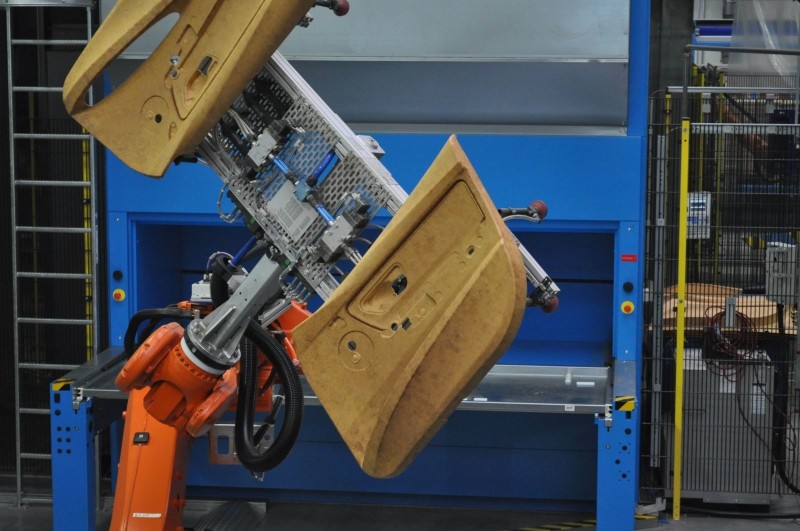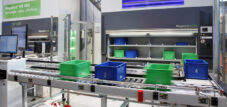Smart logistics solutions are required
A constantly expanding variety of variants, a lack of space on the assembly line and the constant pressure to integrate new technologies into the production process: There is no question that intralogistics are faced with major tasks if they want to successfully master the challenges in automotive production logistics. There are even already voices warning of a collapse in the assembly supply if new approaches are not taken to counteract the overload.
One thing is certain: the automotive industry is characterized by a trend towards permanent innovation. This brings with it new technologies in manufacturing and assembly and thus increases the challenges to the material flow and thus also to logistics. The development towards increasingly profound automation and the use of constantly faster, fully automatic assembly robots mean that logistics must constantly deliver new top performance if the constant and smooth flow of materials is not to dry up.
Where a few years ago the components and replacement parts were removed from conventional shelving units to be taken to the production line, today autonomous, driverless transport systems are used to ensure the smooth provision and loading of the machines. In this way, pre-commissioned assembly sets are now transported to the assembly line just in time, ensuring that production can continue steadily.
However, this presupposes that behind it there is increasingly sophisticated software for planning, control and scheduling decisions, without which functioning automobile production would no longer be possible.
It is up to logisticians to keep up with increasingly efficient processes and software systems and to supply the production lines with supplies in the form of parts and tools. The demands on delivery performance resulting from the higher production output are just one of the challenges.
Increasing individualization leads to increasingly complex processes
The ever-increasing individualization of vehicles, equipment and engines also leads to a constantly growing arsenal of parts and preliminary products that must be kept available for assembly. For example, at the Audi factory in Ingolstadt, only 1.5 vehicles are delivered with exactly the same construction each year. And that is just the current situation, which does not yet take into account future developments in the field of e-mobility. It is not difficult to imagine how much the range of items to be kept in stock will expand once the production of battery-operated vehicles really gets going. The success of the market for vehicles with alternative drives cannot yet be predicted with certainty. For warehouse logistics companies, this results in the risk of under- or over-stocking of components; with significant impact on the internal supply chain.
The material flow in automobile construction – on the verge of collapse?
The increase in the number of parts to be kept means that the space on the tightly scheduled belts is becoming increasingly limited. Since the assembly lines cannot simply be extended and the areas behind them cannot be expanded as desired, a jam of parts rushing towards the belts is virtually inevitable. According to estimates, only 40% of the production area in automobile manufacturing is used for assembly, while the remaining 60% is already reserved for logistics. Until now, automobile manufacturers and their suppliers have often resorted to pre-assembling assemblies elsewhere and only delivering these sets to the assembly line for final assembly. The lack of space was addressed by creating space elsewhere. A method that is born out of necessity and does not necessarily make the processes more efficient. But these temporary spaces are also slowly becoming scarce, and more and more transport systems with pre-assembled sets are clogging up the increasingly long routes to assembly.
The intralogistics manufacturer Kardex Remstar, which has just come onto the market with a new storage lift system called the Vertical Buffer Module, offers a solution. The Kardex Remstar LR 35, the first model in the series, can be used particularly for the pre-assembly of assembly sets and their space-saving intermediate buffering on the production line. Designed for the storage and provision of small parts and light tools, the device handles up to 500 order items per picking station per hour. This makes it well suited for manufacturing companies with a large variety of variants in series production for which the smooth provision of assembly sets on the assembly lines is of the utmost importance. Used as a picking station and intermediate buffer, it ensures that picked assembly sets are ready on the assembly line just-in-time. To do this, order containers with assembly sets are pre-picked on a Kardex Remstar LR 35 and then transported to production, where they are buffered in another storage device in the series. When the assembly set is requested, it is then immediately provided and transported to the assembly line using conveyor technology. This means that incoming assembly orders can be provided without a long lead time, and pre-picking the parts always ensures that the required sets are available complete and error-free at the right time. In addition, the rapid provision of parts directly at the workstation shortens the operating personnel's walking distances and waiting times, which leads to a reduction in the number of personnel required. The highly compacted storage in a small space also guarantees that space is not required too much.
The system therefore offers itself as an efficient solution for the provision of small to medium-sized assembly sets for automobile production. Ultimately, however, only time will tell to what extent solutions such as the Vertical Buffer Module or other technologies will make it possible to ensure functioning assembly supplies in the automotive industry in the long term in the future.


